Paul Barrett’s paper is out showing that the Cat Gap may be more taphonomic than evolutionary. His phylogenetic analysis of feliform carnivores shows that Barbourofelis and its relatives, previously thought to be an independent derivation of sabertoothed habits, are actually nested well within the Nimravidae. This finding indicates that the Early Miocene gap between the last occurrence of non-barbourofeline nimravids and the first occurrence of barbourofelines is not a time period when the Holarctic was without a cat ecomorph, but rather a period when those ecomorphs are not preserved. Biogeographic analysis suggests that the missing fossils may be European or, more likely, African. At least now we know where and when to look for them!
Distinguishing species with Geometric Morphometrics
Megan Wyatt’s thesis using geometric morphometrics to distinguish the dentition of Chaetodipus and Perognathus came out in the Journal of Mammalogy, only a year after she defended the work as her Clark Honors College thesis! This paper demonstrated that these two heteromyid genera, previously regarded as osteologically cryptic, can be distinguished using GM techniques on upper or lower jaws. This is a great jumping-off point for research into the paleontological record of the Chaetodipus–Perognathus split, inferred from molecular evidence to date to the middle Miocene. Go read it for yourself! https://doi.org/10.1093/jmammal/gyab052
SVP Success

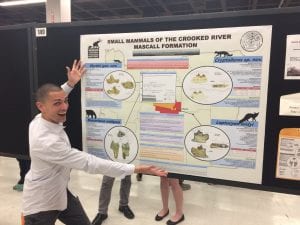
In the month of October our lab spent a week in Albuquerque at the Society of Vertebrate Paleontology annual meeting presenting our research in the form of posters and talks. From pinnipeds to rodents we had a myriad of taxa and topics to present on. It was a successful trip and we had fun visiting old friends and seeing the New Mexico Museum of Natural History and Science. If you want to learn more about the research we presented check out the SVP website where you can read our abstracts.
Outstanding Undergraduate Research
 Four of our undergraduate students presented their research at University of Oregon’s Undergraduate Research Symposium in the spring. One of our lab undergrads, Megan Wyatt, presented a poster on fossil Heteromyidae (pocket mice) from the Mascall formation in Oregon.
Four of our undergraduate students presented their research at University of Oregon’s Undergraduate Research Symposium in the spring. One of our lab undergrads, Megan Wyatt, presented a poster on fossil Heteromyidae (pocket mice) from the Mascall formation in Oregon.
She received the Museum of Natural and Cultural History Poster Award and will be using the award money to present this work at the SVP Conference in Albuquerque!
Congrats Megan we are looking forward to seeing the updates.
Paul’s Summer of Museum Trips
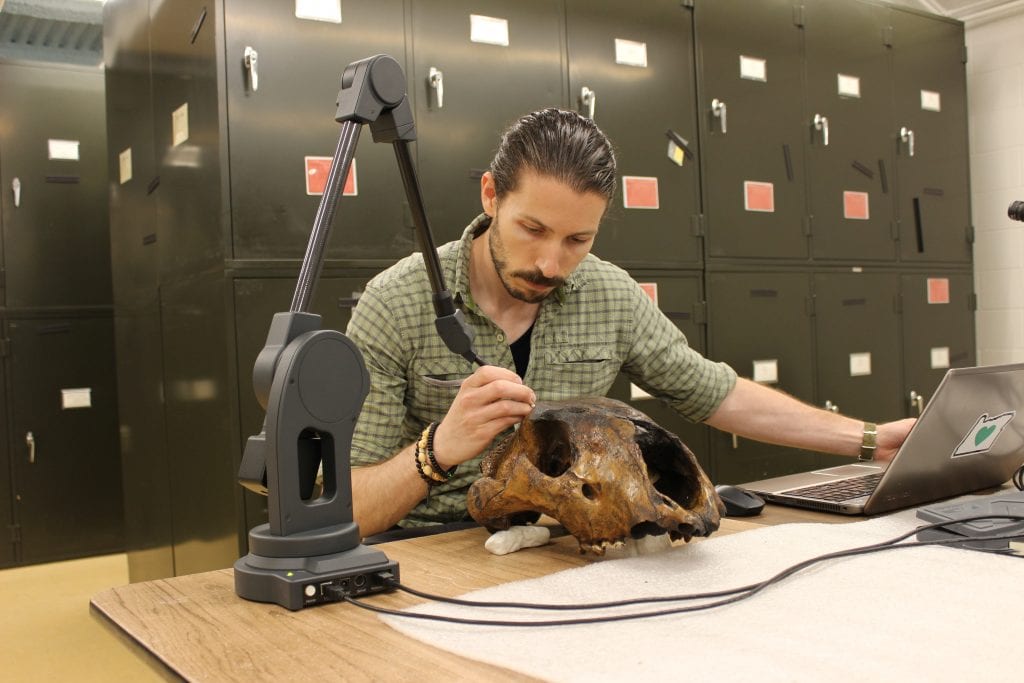 The academic year is in full swing now which means our graduate students are back from data collection. PhD candidate Paul spent most of his summer collecting data for his dissertation on feliform evolutionary history and morphological constraint. He traveled to the American Museum of Natural History (AMNH) in New York City, where he spent a month in the fossil carnivore collection, after which he visited Chicago for an additional two weeks at the Field Museum in their modern mammal collection. By the end of the summer Paul was able to score 70 species of cat-like carnivore for over 300 morphological characters apiece. He also three-dimensionally digitized 110 skulls using the lab’s new Microscribe. A busy, but very productive summer Paul!
The academic year is in full swing now which means our graduate students are back from data collection. PhD candidate Paul spent most of his summer collecting data for his dissertation on feliform evolutionary history and morphological constraint. He traveled to the American Museum of Natural History (AMNH) in New York City, where he spent a month in the fossil carnivore collection, after which he visited Chicago for an additional two weeks at the Field Museum in their modern mammal collection. By the end of the summer Paul was able to score 70 species of cat-like carnivore for over 300 morphological characters apiece. He also three-dimensionally digitized 110 skulls using the lab’s new Microscribe. A busy, but very productive summer Paul!
STEM Outreach
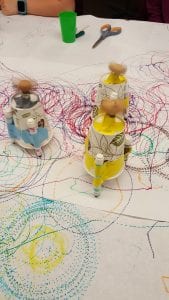 The graduate students in our lab often do more than just teach and research. PhD student Dana, has spent the last year as one of the University of Oregon Women in Graduate Science outreach co-chairs. She got to design and implement fun science events for kids of all ages. She worked with the Eugene Science Center for their GIRLS’ Science Adventure Days, Ophelia’s Place for their STEAM Workshop, and the University of Oregon’s Summer Academy to Inspire Learning, Chemistry Camp to create eye opening yet messy science experiments. She got to make liquid nitrogen ice cream, marker robots, density columns, fossil casts and more!
The graduate students in our lab often do more than just teach and research. PhD student Dana, has spent the last year as one of the University of Oregon Women in Graduate Science outreach co-chairs. She got to design and implement fun science events for kids of all ages. She worked with the Eugene Science Center for their GIRLS’ Science Adventure Days, Ophelia’s Place for their STEAM Workshop, and the University of Oregon’s Summer Academy to Inspire Learning, Chemistry Camp to create eye opening yet messy science experiments. She got to make liquid nitrogen ice cream, marker robots, density columns, fossil casts and more!
You can check out some more of what she did:
https://blogs.uoregon.edu/uowgs/
https://mirandadaviduk.com/women-in-stem/
Kelsey Stilson: Integrative Biology and the furby?
 Kelsey Stilson, a lab alum who graduated in 2013, is taking integrative biology to whole new heights by dissecting furbys! We love the fun idea of comparing them to modern animals while also diving into their design and engineering. Although it is a bit morbid to see them without fur, one might say they were pretty creepy anyway.
Kelsey Stilson, a lab alum who graduated in 2013, is taking integrative biology to whole new heights by dissecting furbys! We love the fun idea of comparing them to modern animals while also diving into their design and engineering. Although it is a bit morbid to see them without fur, one might say they were pretty creepy anyway.
Check out her dissection page here for more furbys: http://www.kstilson.com/furby-dissection.html
Holley’s Summer at Badlands National Park
Holley, a Master’s student working with Edward Davis, has been spending the summer away from Oregon working as a fossil preparator at Badlands National Park.
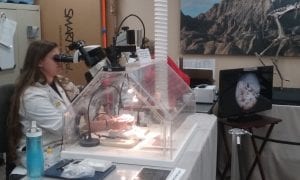
“I’m supported by the Geoscientists in the Parks (GIP) internship program. The GIP program is a faction of Americorps and the Conservation Legacy that has paired with the Geological Society of America to get students into government internships. I’ve had a nice 12 weeks in Badlands preparing Eocene and Miocene mammal fossils. The prep lab at the Ben Reifel Visitor Center is unique in that as preparators work visitors can see the process and ask questions to better understand all the work that goes into displaying fossils.”
Congrats Holley! We are excited to hear about all the Eocene fossils and your time at the visitor center!
Kellum’s Summer of Science
Summer can be a quiet time on campus, but that doesn’t mean much for members of our lab. Both graduate and undergraduate students are hard at work traveling and doing fieldwork.
PhD student Kellum, traveled to the Sternberg Natural History Museum in Hays, Kansas, where she was an assistant instructor for a high school paleontology camp and the instructor of record for a middle school paleontology camp. Following this trip, she traveled to the Smithsonian in D.C., where she spent a week measuring, photographing, and describing the skeletons of modern phocine seals.
Sounds like a science packed summer!
2018 Field Season
We had a great field season this summer out in the Oregon high desert. We ended up collecting fossils from three different localities spanning from the Oligocene into the Miocene. We found lots of interesting fossils such as small dogs, Hypertragulus, and Oredonts. Past lab members and new lab members came out to join us providing much needed support and allowing us to cover more ground.

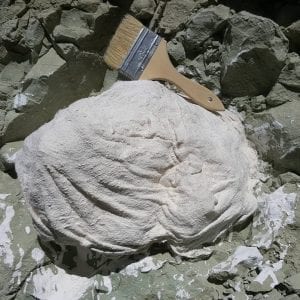
Students learned how to accurately take notes and make plaster jackets in both hard and soft substrate. We even experienced rain and thunderstorms in the desert giving everyone a much needed shower! It was lots of fun and we are already dreaming up plans for next year. Thanks to everyone who came!

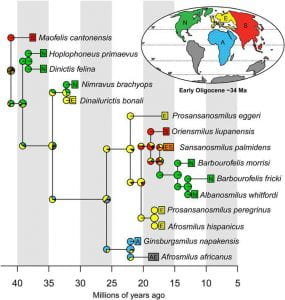

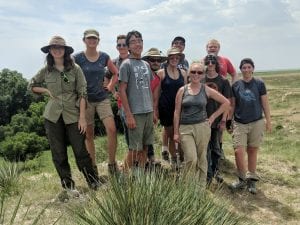
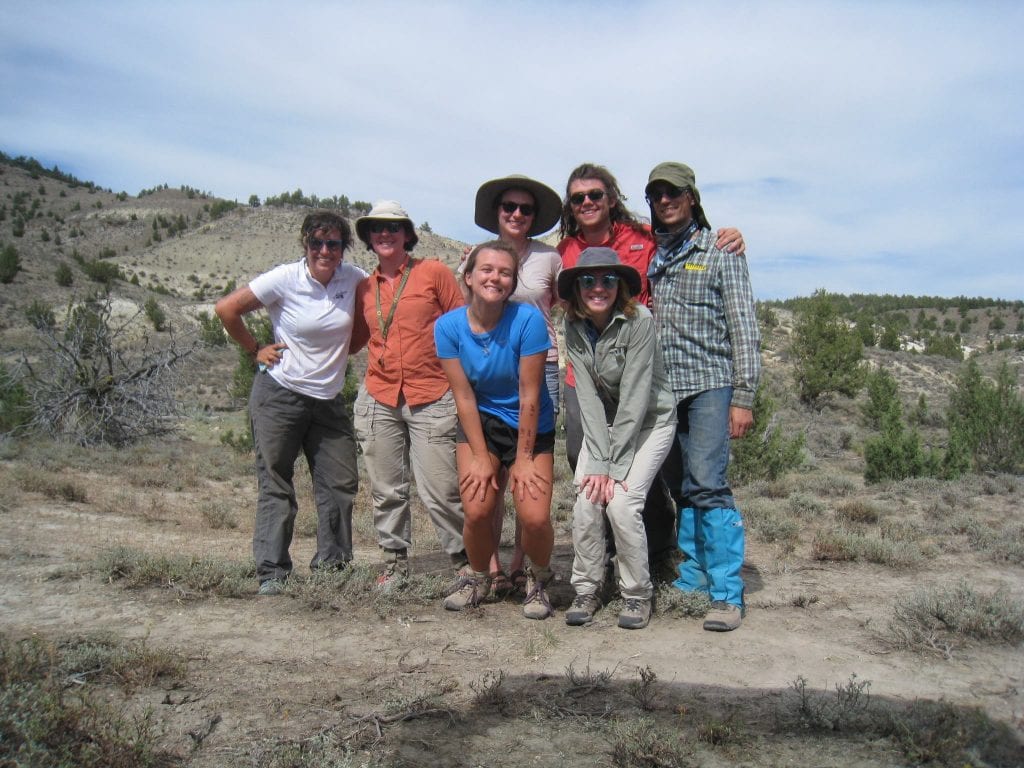
You must be logged in to post a comment.